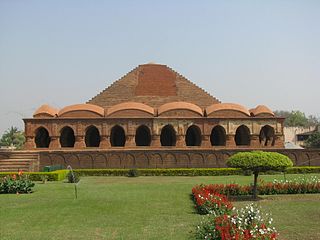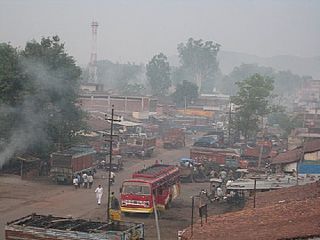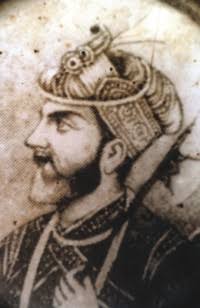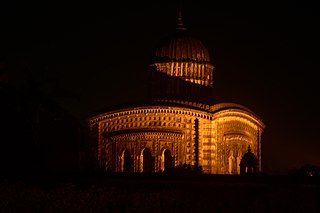
Bankura district is an administrative unit in the Indian state of West Bengal. It is part of Medinipur division—one of the five administrative divisions of West Bengal. Bankura district is surrounded by Purba Bardhaman district and Paschim Bardhaman district in the north, Purulia district in the west, Jhargram district and Paschim Medinipur district in the south, and some part of Hooghly district in the east. Damodar River flows in the northern part of Bankura district and separates it with the major part of Burdwan district. The district head quarter is located in Bankura town.

The Bangash, Bungish, Bangaš or Bangakh are a tribe of Pashtuns, inhabiting their traditional homeland, historically known as Bangash district, which stretches from Kohat to Tall in Hangu and Spīn Ghar in Khyber Pakhtunkhwa, Pakistan. They also live as a smaller population in Ismail Khel, Bannu while also in Gardez, Paktia, Afghanistan. The Bangash are also settled in large numbers in Uttar Pradesh, India, especially in the city of Farrukhabad, which was founded in 1714 by Nawab Muhammad Khan Bangash.

Latehar is a town which is a headquarter of Latehar district of Jharkhand state, it is known for its natural environment, forest, forest products and mineral deposits. Latehar remained a part of Palamau District as a sub division since 1924. It was elevated from sub divisional status to a district on 4 April 2001, vide Jharkhand Government Notification No 946 dated 04.04.2001. Latehar is located on the north–west corner of Jharkhand in the Palamau Commissionary. It is surrounded by Ranchi, Lohardaga, Gumla, Palamu and Chatra district apart from Chhattisgarh state and district headquarters is situated at 84.51198 East Longitude and 23.741988 North Latitude.

Isa Khan was the Bais Rajput leader of the 16th-century Baro-Bhuiyan chieftains of Bengal. During his reign, he successfully unified the chieftains of Bengal and resisted the Mughal invasion of Bengal. It was only after his death that the region fell totally under Mughal control. He remains an iconic figure throughout West Bengal and Bangladesh as a symbol of his rebellious spirit and unity.

The Battle of Tukaroi, also known as the Battle of Bajhaura or the Battle of Mughulmari, was fought between the Mughal Empire and the Bengal Sultanate on 3 March 1575 near the village of Tukaroi in present-day Balasore District of Odisha. It resulted in a Mughal victory and greatly weakened the Bengal Sultanate.

The unification of Nepal was the process of building the modern Nepalese state, from fractured petty kingdoms including the Baise Rajya and the Chaubisi Rajya, which began in 1743 AD. The prominent figure in the unification campaign was Prithvi Narayan Shah, King of Gorkha. On 25 September 1768, he officially announced the creation of the Kingdom of Nepal and moved his capital from Gorkha to the city of Kathmandu.

Raghunathrao Bhat, also known as Ragho Ballal or Ragho Bharari, was the 11th Peshwa of the Maratha Empire for a brief period from 1773 to 1774. He was known among the Hindus for his extremely successful Delhi and North-western campaign in 1757–59 and for his works to liberate the Hindu holy places of Kashi and Ayodhya.

Bishnupur is a city and a municipality of Bankura district in the state of West Bengal, India. It is known for its terracotta temples built by the Malla rulers, historic Radha Krishna temples built during 1600–1800 CE and the Baluchari sarees.

Daud Khan Karrani was the last ruler of Bengal's Karrani dynasty as well as the final Sultan of Bengal, reigning from 1572 to 1576. During the reign of his father Sulaiman Khan Karrani, Daud commanded a massive army of 40,000 cavalry, 3,600 elephants, 140,000 infantry and 200 cannons.
The Maratha invasions of Bengal (1741–1751), also known as the Maratha expeditions in Bengal, were the frequent invasions by the Maratha forces in the Bengal Subah, after their successful campaign in the Carnatic region at the Battle of Trichinopoly. The leader of the expeditions was Raghoji Bhonsle of Nagpur. The Marathas invaded Bengal five times from August 1741 to May 1751, which caused widespread economic losses in the Bengal Subah.

History of Bankura district refers to the history of the present Bankura district in the Indian state of West Bengal.

Hussain Quli Beg was a Mughal military vassall (mansabdar) with the rank of 5000 soldiers. He was later entitled as Khān-i-Jahān by Emperor Akbar.

Rudranarayan Raymukhuty was a Bengali Kulin Brahmin King of Raymukhuti (Mukhopadhyay) dynasty of Bhurishrestha in Bengal. He started rivalry with the Lohani Pathan sultans of Bengal Sultanate.
Hambir Malla Dev was the forty-ninth king of Mallabhum. He ruled from 1565 to 1620 AD.

Munʿim Khān was a Mughal general under both emperors Humayun and Akbar. He was titled Khān-i-Khānān when Emperor Akbar appointed him as Prime Minister of the Mughal Empire in 1560. In 1564, he became the Subahdar of Jaunpur. Munim Khan was the first Mughal governor of Bengal Subah from 1574 to 1575 and Kabul in two separate terms from 1556 to 1560 and 1563 to 1575.
The Karrani dynasty was founded in 1564 by Taj Khan Karrani, an ethnic Afghan from the Karlani tribe, hailing from Bangash district. It was the last dynasty to rule the Sultanate of Bengal.
Kalapahada or Kala Pahar was a Brahmin born Muslim General of the Bengal Sultanate under the reigning Karrani Dynasty.
Medini Rai'a.k.a.Madini Rai or Madini Rao' ruled from 1658 to 1674 in the Palamu region of Bihar, now in Jharkhand.
Khawāja Uthmān Khān Lōhānī, popularly known as Khwaja Usman, was a Pashtun chieftain and warrior based in northeastern Bengal. As one of the Baro-Bhuyans, he was a zamindar ruling over the northern parts of Bengal including Greater Mymensingh and later in South Sylhet. He was a formidable opponent to Man Singh I and the Mughal Empire, and was the last of the Afghan chieftains and rulers in Bengal. His defeat led to the surrender of all the remaining Pashtuns as well as the incorporation of the Sylhet region into the Bengal Subah. He is described as the most romantic figure in the history of Bengal. His biography can be found in the Baharistan-i-Ghaibi, Tuzk-e-Jahangiri as well as the Akbarnama.
The Battle of Delhi (1764) was fought between the Jat ruler of Bharatpur and the Mughal rulers of Mughal Empire. Maharaja Jawahar Singh of Bharatpur invaded Delhi and laid siege to stronghold of Red Fort.










